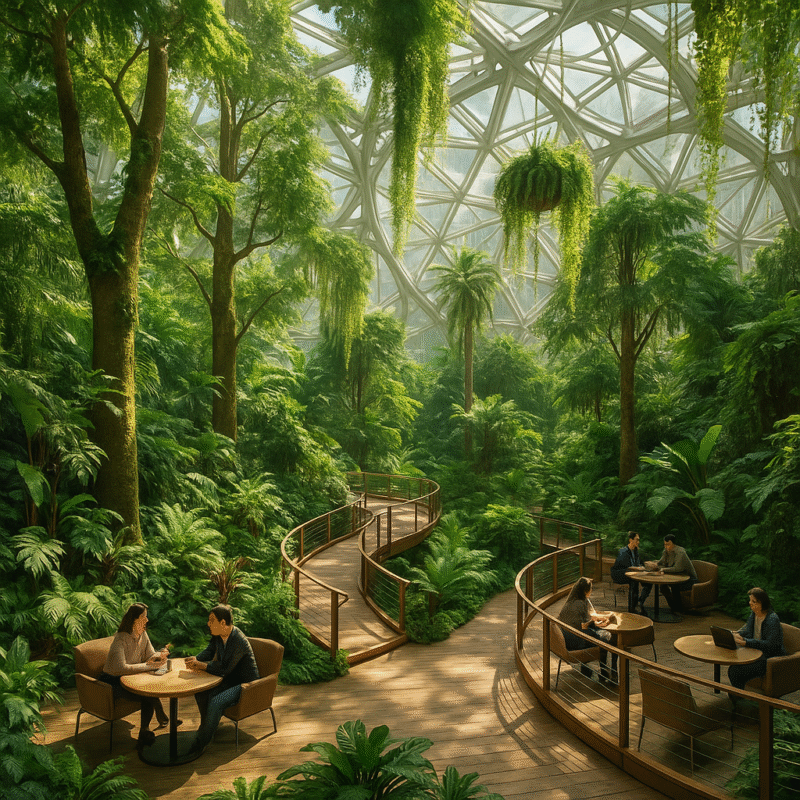In our biophilic design series, we’ve explored the principles of bringing nature into architecture and the practical techniques architects use to create nature-inspired interiors. Now, let’s zoom in on a real-world example that showcases biophilic design at its most ambitious: Amazon’s The Spheres in Seattle, USA. This iconic workplace, designed by NBBJ, is a testament to how biophilic design can transform urban workspaces, boosting employee well-being, creativity, and sustainability. For architecture students, The Spheres offers a masterclass in balancing bold vision with practical execution. This article dives into the project’s biophilic elements, its measurable impacts, and the lessons you can apply to your own designs. By the end, you’ll be inspired to reimagine workspaces as vibrant, nature-infused environments—and maybe even sketch one yourself.
The Spheres: An Overview
Opened in 2018, The Spheres are three glass-domed structures integrated into Amazon’s urban campus in Seattle’s Denny Triangle. Unlike traditional office buildings, The Spheres are an indoor rainforest, housing over 40,000 plants from 30 countries, winding pathways, and collaborative workspaces. Designed to foster innovation and relaxation for Amazon employees, the project embodies biophilic design’s core mission: to reconnect people with nature in densely built environments.
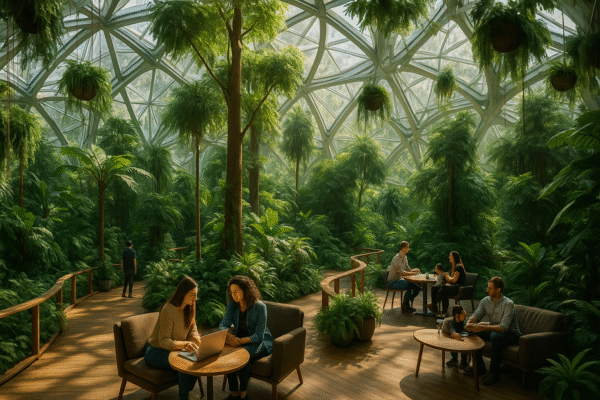
In 2025, The Spheres remain a global benchmark for workplace design, especially as companies prioritize employee mental health and sustainability post-pandemic. The project’s success lies in its seamless integration of nature into a high-tech, urban setting, proving that biophilic design can thrive even in corporate contexts. For students, The Spheres offer a case study in how architecture can address modern challenges—stress, disconnection from nature, and environmental impact—while creating functional, inspiring spaces.
Biophilic Design Elements in The Spheres
The Spheres incorporate a range of biophilic design strategies, drawing from the principles we discussed in our first article: direct experience of nature, indirect experience of nature, and experience of space and place. Below, we analyze the key elements that make The Spheres a biophilic masterpiece.
1. Direct Experience of Nature: Indoor Rainforest and Greenery
At the heart of The Spheres is its lush indoor ecosystem, featuring trees, ferns, orchids, and epiphytes across multiple levels. The planting scheme mimics a tropical rainforest, with a 60-foot “Rubi” ficus tree as a centerpiece.
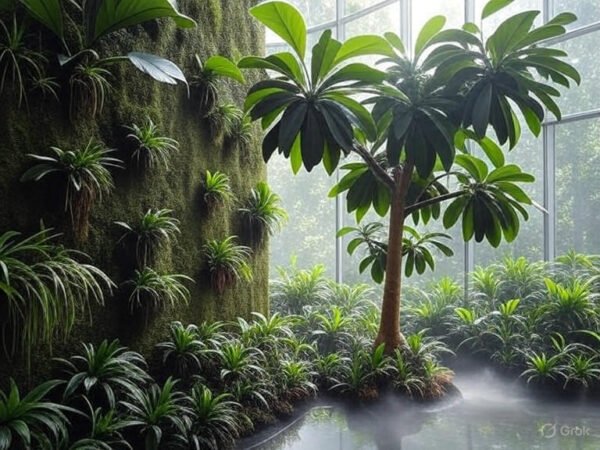
-
Implementation: Plants are supported by custom irrigation and climate control systems, maintaining humidity and temperature akin to a natural forest. Living walls and hanging gardens maximize greenery in vertical spaces.
-
Impact: The dense vegetation provides a visual and sensory connection to nature, reducing stress and enhancing mood, as supported by studies like those in Scientific Reports (2019) showing nature exposure lowers cortisol levels.
-
Student Takeaway: Consider how vertical greenery can transform small spaces. In a studio project, design a compact atrium with a living wall to mimic this effect.
2. Direct Experience of Nature: Dynamic Natural Light
The Spheres’ glass domes, composed of pentagonal panels, flood the interior with natural light, creating dynamic patterns that shift with the sun.
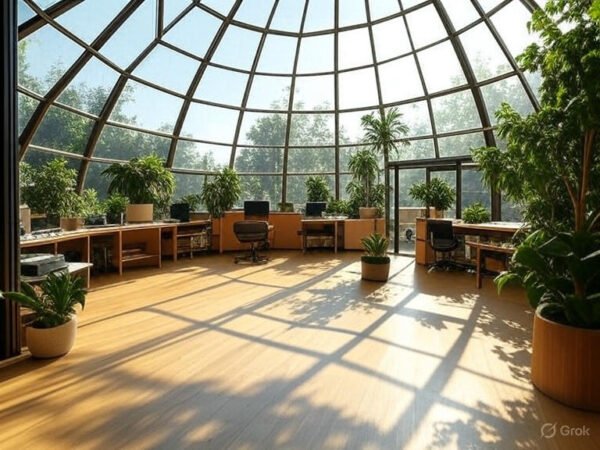
-
Implementation: The transparent structure allows daylight to penetrate deep into the space, supplemented by skylights and reflective surfaces. Automated shades adjust to prevent glare, ensuring comfort.
-
Impact: Natural light regulates employees’ circadian rhythms, improving sleep and focus, as evidenced by research from the University of Illinois (2015) on daylight in workplaces.
-
Student Takeaway: Experiment with light wells or large windows in your designs, balancing daylight with glare control. Sketch a workspace with a skylight to study light patterns.
3. Indirect Experience of Nature: Natural Materials
The interiors feature organic materials like reclaimed wood, bamboo, and stone, used in walkways, furniture, and accent walls.
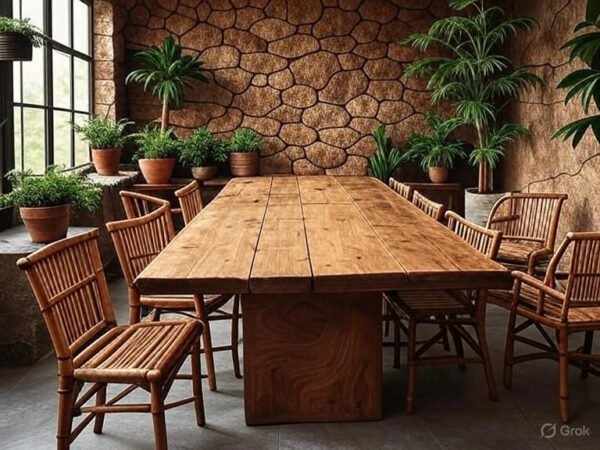
-
Implementation: Wooden bridges and benches evoke a forest trail, while stone floors add earthy textures. Materials are sustainably sourced, aligning with biophilic design’s environmental ethos.
-
Impact: These textures create a tactile connection to nature, making the space feel warm and authentic, which enhances user comfort.
-
Student Takeaway: Incorporate one natural material, like reclaimed timber, into your next model. Research local suppliers for sustainable options.
4. Experience of Space and Place: Prospect and Refuge
The Spheres balance open, expansive areas with cozy, sheltered nooks, embodying the biophilic pattern of prospect and refuge.
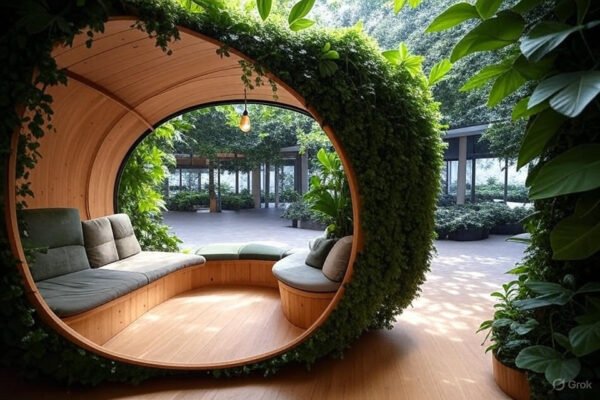
-
Implementation: Open plazas with high ceilings offer “prospect” for collaboration, while treehouse-like meeting pods and cushioned alcoves provide “refuge” for focused work or relaxation.
-
Impact: This spatial variety caters to diverse work styles, boosting productivity and satisfaction, as shown in workplace studies by Gensler (2020).
-
Student Takeaway: Design a workspace with both open and enclosed areas. Try modeling a small pavilion with a shaded nook to test this balance.
5. Biomorphic Forms and Patterns
The Spheres’ domed structure and organic interior layouts mimic natural forms, with curved pathways and plant-inspired patterns.
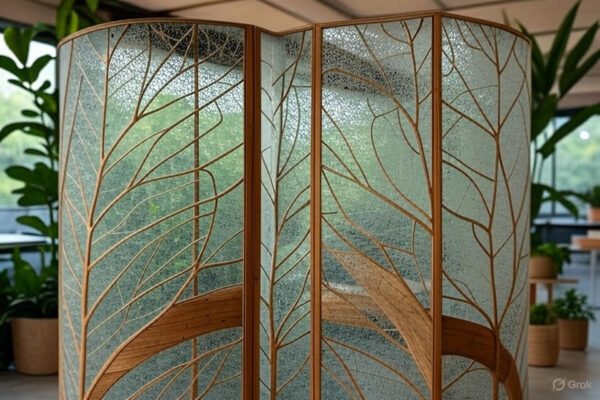
-
Implementation: The glass domes resemble cellular structures, and interior partitions feature leaf-like perforations, subtly evoking nature.
-
Impact: These forms create a subconscious connection to the natural world, enhancing the space’s aesthetic and emotional resonance.
-
Student Takeaway: Add a biomorphic element, like a curved wall, to a studio project. Use 3D modeling tools to explore organic shapes.
These elements work together to create an immersive environment that feels like a living, breathing ecosystem, not just an office. For students, The Spheres demonstrate how multiple biophilic strategies can be layered to achieve a cohesive, impactful design.
Measurable Outcomes: The Impact of The Spheres
The Spheres’ biophilic design has delivered tangible benefits, supported by data and user feedback, making it a compelling case study for 2025’s focus on workplace well-being.
1. Enhanced Employee Well-Being
Employees report lower stress and higher satisfaction when working in The Spheres compared to traditional offices. A 2019 internal Amazon survey (cited in design publications) found that 78% of employees felt more relaxed after spending time in the space.
-
Why It Matters: Reduced stress correlates with lower absenteeism and better mental health, aligning with biophilic design’s health benefits discussed in our first article.
-
Student Application: Use this data to justify biophilic interventions in your project proposals, emphasizing user well-being.
2. Increased Creativity and Productivity
The Spheres’ nature-inspired environment fosters innovation. A 2020 study by the University of Oregon found that biophilic workplaces increase creative problem-solving by up to 15%. Amazon employees use the space for brainstorming and informal meetings, reporting improved collaboration.
-
Why It Matters: In 2025, companies value spaces that boost creativity, making biophilic design a competitive edge.
-
Student Application: Design a studio workspace with greenery and natural light to enhance creative output, citing similar studies.
3. Sustainability Benefits
The Spheres incorporate energy-efficient systems, including passive cooling, rainwater harvesting, and sustainable materials, reducing the building’s carbon footprint.
-
Why It Matters: These features align with global sustainability goals, a key trend in 2025 architecture.
-
Student Application: Include one sustainable feature, like a green roof, in your next project to mirror The Spheres’ eco-conscious approach.
4. Community and Social Engagement
The Spheres occasionally open to the public, fostering community connection through tours and events. This aligns with biophilic design’s ability to create shared, nature-rich spaces.
-
Why It Matters: Public access strengthens the project’s social impact, showing how workplaces can serve broader communities.
-
Student Application: Design a hybrid workspace with a public-access green area, exploring how biophilic design can bridge private and public realms.
These outcomes highlight why The Spheres are more than a corporate showpiece—they’re a model for future workplaces. For students, these results provide evidence to advocate for biophilic design in academic and professional settings.
Lessons for Students: Balancing Vision and Practicality
The Spheres offer several lessons for aspiring architects, showing how to translate biophilic principles into functional designs while navigating real-world constraints.
1. Integration Over Decoration
The Spheres don’t just add plants—they integrate nature into the building’s structure, systems, and user experience. Every element, from the domes to the irrigation, serves a purpose.
-
How to Apply: In your projects, ensure biophilic features enhance functionality, not just aesthetics. For example, a green wall should improve air quality and mood, not just look pretty.
2. Collaboration with Experts
NBBJ worked with horticulturists, engineers, and sustainability consultants to realize The Spheres’ vision, ensuring plants thrived and systems were efficient.
-
How to Apply: In studio, simulate collaboration by researching plant maintenance or consulting peers on structural design. This builds interdisciplinary skills.
3. Scalability and Adaptation
While The Spheres are grand, their principles—greenery, light, materials—can be scaled down for smaller projects, like cafés or classrooms.
-
How to Apply: Design a modest workspace with one or two biophilic elements, like a skylight and wooden furniture, to practice adaptability.
4. Data-Driven Design
The Spheres’ success is backed by data on employee well-being and sustainability, making a strong case for biophilic investment.
-
How to Apply: Support your designs with research, such as studies on natural light’s impact, to persuade professors or hypothetical clients.
These lessons empower students to approach biophilic design with both creativity and pragmatism, preparing you for real-world challenges.
Getting Started: Your Biophilic Workspace Challenge
You don’t need Amazon’s budget to explore biophilic design. Here’s how to apply The Spheres’ lessons in your academic work:
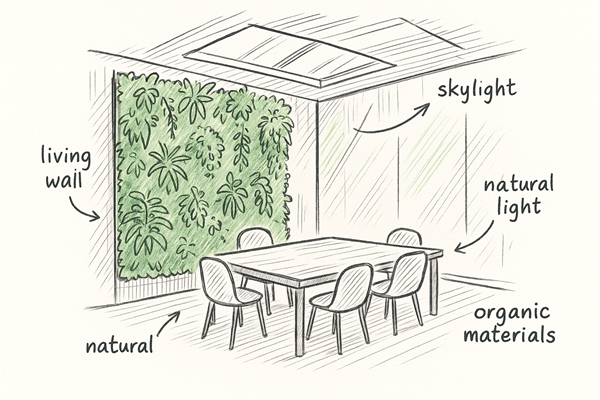
-
Studio Project: Design a small urban workspace (e.g., a 500-square-foot co-working space) with at least three biophilic elements inspired by The Spheres, such as a living wall, natural light, and a biomorphic partition. Document how these enhance user experience.
-
Site Visit: Visit a local office or public building and identify opportunities for biophilic retrofits. Could a lobby use plants? Could windows be enlarged? Write a one-page proposal.
-
Sketching Challenge: Sketch a biophilic meeting room inspired by The Spheres’ treehouse pods. Include a green wall, dynamic light, and a wooden table. Annotate how each element supports well-being. Share your sketch on our forum or social media with #BiophilicStudentDesign.
-
Research: Study another biophilic workplace, like Google’s green offices, and compare it to The Spheres. Present your findings in a short essay or class discussion.
Try this exercise: Visit a local workspace (e.g., a library or café) and note its biophilic potential. Then, sketch a retrofit that adds one element from The Spheres, like a living wall. Post your ideas on www.architecture-student.com’s comment section—we’re excited to see your vision!
Conclusion: Redefining Workspaces with Nature
Amazon’s The Spheres prove that biophilic design can revolutionize urban workspaces, creating environments that nurture creativity, health, and sustainability. By blending greenery, natural light, and organic forms, the project sets a standard for 2025’s human-centric architecture. For architecture students, The Spheres are a call to action: design spaces that don’t just function but inspire and heal.
This is the third article in our biophilic design series. Next, we’ll explore how biophilic design synergizes with sustainability, creating climate-conscious architecture for the future. In the meantime, take a moment to observe your own workspace. How could a touch of nature transform it? Share your thoughts and sketches with us!
Biophilic Article Series:
- Understanding Biophilic Design: Principles & Benefits
-
Biophilic Design in Practice: How Architects Are Bringing Nature Indoors
- Case Study: The Impact of Biophilic Design in Urban Workspaces
- How Biophilic Design synergizes with sustainability?
